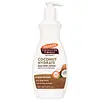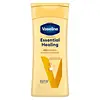What's inside
What's inside
 Key Ingredients
Key Ingredients

 Benefits
Benefits

 Concerns
Concerns

 Ingredients Side-by-side
Ingredients Side-by-side

Water
Skin ConditioningCocos Nucifera Fruit Extract
EmollientGlycine Soja Oil
EmollientButyrospermum Parkii Butter
Skin ConditioningIsopropyl Myristate
EmollientPropylene Glycol
HumectantCetyl Alcohol
EmollientPalmitic Acid
EmollientStearic Acid
CleansingCocos Nucifera Oil
MaskingTheobroma Cacao Seed Butter
EmollientTocopherol
AntioxidantTocopheryl Acetate
AntioxidantGardenia Taitensis Flower Extract
Skin ConditioningPrunus Amygdalus Dulcis Oil
Skin ConditioningMacadamia Ternifolia Seed Oil
EmollientAloe Barbadensis Leaf Juice
Skin ConditioningNonfat Dry Milk
Skin ConditioningCitric Acid
BufferingPotassium Sorbate
PreservativeSodium Benzoate
MaskingTriethanolamine
BufferingEthylhexylglycerin
Skin ConditioningCarbomer
Emulsion StabilisingGlycerin
HumectantPEG-40 Stearate
EmulsifyingTetrasodium EDTA
Pentylene Glycol
Skin ConditioningDecylene Glycol
Skin Conditioning1,2-Hexanediol
Skin ConditioningStearyl Alcohol
EmollientPhenoxyethanol
PreservativeParfum
MaskingBenzyl Alcohol
PerfumingBenzyl Benzoate
AntimicrobialCoumarin
PerfumingWater, Cocos Nucifera Fruit Extract, Glycine Soja Oil, Butyrospermum Parkii Butter, Isopropyl Myristate, Propylene Glycol, Cetyl Alcohol, Palmitic Acid, Stearic Acid, Cocos Nucifera Oil, Theobroma Cacao Seed Butter, Tocopherol, Tocopheryl Acetate, Gardenia Taitensis Flower Extract, Prunus Amygdalus Dulcis Oil, Macadamia Ternifolia Seed Oil, Aloe Barbadensis Leaf Juice, Nonfat Dry Milk, Citric Acid, Potassium Sorbate, Sodium Benzoate, Triethanolamine, Ethylhexylglycerin, Carbomer, Glycerin, PEG-40 Stearate, Tetrasodium EDTA, Pentylene Glycol, Decylene Glycol, 1,2-Hexanediol, Stearyl Alcohol, Phenoxyethanol, Parfum, Benzyl Alcohol, Benzyl Benzoate, Coumarin
Water
Skin ConditioningGlycerin
HumectantStearic Acid
CleansingPalmitic Acid
EmollientIsopropyl Myristate
EmollientParaffinum Liquidum
EmollientPetrolatum
EmollientAvena Sativa Straw Extract
Skin ConditioningDimethicone
EmollientDihydroxypropyltrimonium Chloride
HumectantHydroxyethyl Urea
HumectantPropylene Glycol
HumectantLactic Acid
BufferingGlyceryl Stearate
EmollientGlycol Stearate
EmollientPEG-100 Stearate
Cetyl Alcohol
EmollientStearamide Amp
Sodium Hydroxide
BufferingTapioca Starch
Magnesium Aluminum Silicate
AbsorbentAcrylates/C10-30 Alkyl Acrylate Crosspolymer
Emulsion StabilisingXanthan Gum
EmulsifyingDisodium EDTA
Parfum
MaskingMethylparaben
PreservativePhenoxyethanol
PreservativePropylparaben
PreservativeAlpha-Isomethyl Ionone
PerfumingAmyl Cinnamal
PerfumingButylphenyl Methylpropional
PerfumingCitronellol
PerfumingCoumarin
PerfumingHexyl Cinnamal
PerfumingGeraniol
PerfumingBenzyl Alcohol
PerfumingLimonene
PerfumingLinalool
PerfumingWater, Glycerin, Stearic Acid, Palmitic Acid, Isopropyl Myristate, Paraffinum Liquidum, Petrolatum, Avena Sativa Straw Extract, Dimethicone, Dihydroxypropyltrimonium Chloride, Hydroxyethyl Urea, Propylene Glycol, Lactic Acid, Glyceryl Stearate, Glycol Stearate, PEG-100 Stearate, Cetyl Alcohol, Stearamide Amp, Sodium Hydroxide, Tapioca Starch, Magnesium Aluminum Silicate, Acrylates/C10-30 Alkyl Acrylate Crosspolymer, Xanthan Gum, Disodium EDTA, Parfum, Methylparaben, Phenoxyethanol, Propylparaben, Alpha-Isomethyl Ionone, Amyl Cinnamal, Butylphenyl Methylpropional, Citronellol, Coumarin, Hexyl Cinnamal, Geraniol, Benzyl Alcohol, Limonene, Linalool
Ingredients Explained
These ingredients are found in both products.
Ingredients higher up in an ingredient list are typically present in a larger amount.
Benzyl Alcohol is most commonly used as a preservative. It also has a subtle, sweet smell. Small amounts of Benzyl Alcohol is not irritating and safe to use in skincare products. Most Benzyl Alcohol is derived from fruits such as apricots.
Benzyl Alcohol has both antibacterial and antioxidant properties. These properties help lengthen the shelf life of products. Benzyl Alcohol is a solvent and helps dissolve other ingredients. It can also improve the texture and spreadability.
Alcohol comes in many different forms. Different types of alcohol will have different effects on skin. This ingredient is an astringent alcohol.
Using high concentrations of these alcohols are drying on the skin. They may strip away your skin's natural oils and even damage your skin barrier. Astringent alcohols may also irritate skin.
Other types of astringent alcohols include:
According to the National Rosacea Society based in the US, you should be mindful of products with these alcohols in the top half of ingredients.
Any type of sanitizing product will have high amounts of alcohol to help kill bacteria and viruses.
Learn more about Benzyl AlcoholCetyl Alcohol is a fatty alcohol. Fatty Alcohols are most often used as an emollient or to thicken a product.
Its main roles are:
Though it has "alcohol" in the name, it is not related to denatured alcohol or ethyl alcohol.
The FDA allows products labeled "alcohol-free" to have fatty alcohols.
Learn more about Cetyl AlcoholCoumarins are a group of substances found naturally in plants. There are over 1300 types of coumarins identified. It has a natural vanilla scent.
Coumarin is an identified EU known allergy, meaning it may cause an allergic reaction when applied to the skin.
In many countries, coumarin is banned as a food additive. However, it can be found in soaps, tobacco products, and some alcohol drinks.
Plants use coumarins as a chemical defense. Some plants that have coumarins include lavender, tonka beans, and yellow clovers.
Learn more about CoumarinGlycerin is already naturally found in your skin. It helps moisturize and protect your skin.
A study from 2016 found glycerin to be more effective as a humectant than AHAs and hyaluronic acid.
As a humectant, it helps the skin stay hydrated by pulling moisture to your skin. The low molecular weight of glycerin allows it to pull moisture into the deeper layers of your skin.
Hydrated skin improves your skin barrier; Your skin barrier helps protect against irritants and bacteria.
Glycerin has also been found to have antimicrobial and antiviral properties. Due to these properties, glycerin is often used in wound and burn treatments.
In cosmetics, glycerin is usually derived from plants such as soybean or palm. However, it can also be sourced from animals, such as tallow or animal fat.
This ingredient is organic, colorless, odorless, and non-toxic.
Glycerin is the name for this ingredient in American English. British English uses Glycerol/Glycerine.
Learn more about GlycerinIsopropyl Myristate is an emollient, thickening agent, and texture enhancer. It is created from isopropyl alcohol and myristic acid.
It is used to help other ingredients be better absorbed. It is also an emollient and may help soften and hydrate the skin.
The comedogenic rating of this ingredient depends on the concentration. Lower amounts results in a lower rating.
Isopropyl Myristate may not be fungal acne safe. It can potentially worsen acne prone skin.
Learn more about Isopropyl MyristatePalmitic Acid is a fatty acid naturally found in our skin and in many plant and animal sources. In cosmetics, it is usually derived from palm oil. It serves many purposes in skincare, acting as a cleanser, emollient, and emulsifier.
As an emollient, palmitic acid helps soften and smooth the skin by preventing water loss. In cleansers, it helps remove oil and dirt while creating foam.
Its emulsifying properties help stabilize products by keeping water and oil-based ingredients from separating.
This may not be suitable for fungal acne-prone skin, as fatty acids like this can sometimes trigger breakouts in sensitive individuals.
Learn more about Palmitic AcidParfum is a catch-all term for an ingredient or more that is used to give a scent to products.
Also called "fragrance", this ingredient can be a blend of hundreds of chemicals or plant oils. This means every product with "fragrance" or "parfum" in the ingredients list is a different mixture.
For instance, Habanolide is a proprietary trade name for a specific aroma chemical. When used as a fragrance ingredient in cosmetics, most aroma chemicals fall under the broad labeling category of “FRAGRANCE” or “PARFUM” according to EU and US regulations.
The term 'parfum' or 'fragrance' is not regulated in many countries. In many cases, it is up to the brand to define this term.
For instance, many brands choose to label themselves as "fragrance-free" because they are not using synthetic fragrances. However, their products may still contain ingredients such as essential oils that are considered a fragrance by INCI standards.
One example is Calendula flower extract. Calendula is an essential oil that still imparts a scent or 'fragrance'.
Depending on the blend, the ingredients in the mixture can cause allergies and sensitivities on the skin. Some ingredients that are known EU allergens include linalool and citronellol.
Parfum can also be used to mask or cover an unpleasant scent.
The bottom line is: not all fragrances/parfum/ingredients are created equally. If you are worried about fragrances, we recommend taking a closer look at an ingredient. And of course, we always recommend speaking with a professional.
Learn more about ParfumPhenoxyethanol is a preservative that has germicide, antimicrobial, and aromatic properties. Studies show that phenoxyethanol can prevent microbial growth. By itself, it has a scent that is similar to that of a rose.
It's often used in formulations along with Caprylyl Glycol to preserve the shelf life of products.
Propylene Glycol is an odorless, colorless liquid. As a humectant, it helps skin retain moisture. It also aids in delivering active ingredients.
Another role of this ingredient is preventing a product from melting or freezing. Propylene glycol also adds antimicrobrial properties to a product, elongating product lifespan.
This ingredient is considered an organic alcohol and commonly added into both cosmetics and foods.
Those with sensitive skin or conditions may develop a rash when using this ingredient.
Learn more about Propylene GlycolStearic Acid is a fatty acid. It is an emollient, emulsifier, and texture enhancer.
As an emollient, stearic acid helps soften skin. It aids the skin's protective barrier by preventing water loss. It also provides a gentle cleansing effect without stripping away natural oils.
Stearic acid may also be used to enhance the texture of products. It can add volume and stabilize ingredients such as water and oil. This can help water and oil ingredients from separating.
Sources of stearic acid include animal or vegetable fats/oils such as coconut or shea. It can be naturally found in butter, cocoa butter, shea butter, vegetable fats, and animal tallow.
This ingredient may not be Malassezia folliculitis, or fungal-acne safe.
Learn more about Stearic AcidWater. It's the most common cosmetic ingredient of all. You'll usually see it at the top of ingredient lists, meaning that it makes up the largest part of the product.
So why is it so popular? Water most often acts as a solvent - this means that it helps dissolve other ingredients into the formulation.
You'll also recognize water as that liquid we all need to stay alive. If you see this, drink a glass of water. Stay hydrated!
Learn more about Water